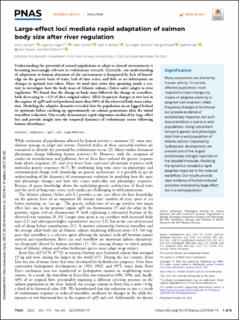| dc.contributor.author | Jensen, Arne Johan | |
| dc.contributor.author | Hagen, Ingerid Julie | |
| dc.contributor.author | Czorlich, Yann | |
| dc.contributor.author | Bolstad, Geir Hysing | |
| dc.contributor.author | Bremset, Gunnbjørn | |
| dc.contributor.author | Finstad, Bengt | |
| dc.contributor.author | Hindar, Kjetil | |
| dc.contributor.author | Skaala, Øystein | |
| dc.contributor.author | Karlsson, Sten | |
| dc.date.accessioned | 2022-11-29T15:05:52Z | |
| dc.date.available | 2022-11-29T15:05:52Z | |
| dc.date.created | 2022-11-03T10:51:16Z | |
| dc.date.issued | 2022 | |
| dc.identifier.citation | Proceedings of the National Academy of Sciences of the United States of America. 2022, 119 (44), . | en_US |
| dc.identifier.issn | 0027-8424 | |
| dc.identifier.uri | https://hdl.handle.net/11250/3034823 | |
| dc.description.abstract | Understanding the potential of natural populations to adapt to altered environments is becoming increasingly relevant in evolutionary research. Currently, our understanding of adaptation to human alteration of the environment is hampered by lack of knowledge on the genetic basis of traits, lack of time series, and little or no information on changes in optimal trait values. Here, we used time series data spanning nearly a century to investigate how the body mass of Atlantic salmon (Salmo salar) adapts to river regulation. We found that the change in body mass followed the change in waterflow, both decreasing to ∼1/3 of their original values. Allele frequency changes at two loci in the regions of vgll3 and six6 predicted more than 80% of the observed body mass reduction. Modeling the adaptive dynamics revealed that the population mean lagged behind its optimum before catching up approximately six salmon generations after the initial waterflow reduction. Our results demonstrate rapid adaptation mediated by large-effect loci and provide insight into the temporal dynamics of evolutionary rescue following human disturbance. | en_US |
| dc.language.iso | eng | en_US |
| dc.publisher | National Academy of Sciences | en_US |
| dc.relation.uri | hdl.handle.net/11250/3031352 | |
| dc.rights | Navngivelse 4.0 Internasjonal | * |
| dc.rights.uri | http://creativecommons.org/licenses/by/4.0/deed.no | * |
| dc.title | Large-effect loci mediate rapid adaptation of salmon body size after river regulation | en_US |
| dc.title.alternative | Large-effect loci mediate rapid adaptation of salmon body size after river regulation | en_US |
| dc.type | Peer reviewed | en_US |
| dc.type | Journal article | en_US |
| dc.description.version | publishedVersion | en_US |
| dc.subject.nsi | VDP::Zoologiske og botaniske fag: 480 | en_US |
| dc.subject.nsi | VDP::Zoology and botany: 480 | en_US |
| dc.source.pagenumber | 8 | en_US |
| dc.source.volume | 119 | en_US |
| dc.source.journal | Proceedings of the National Academy of Sciences of the United States of America | en_US |
| dc.source.issue | 44 | en_US |
| dc.identifier.doi | 10.1073/pnas.2207634119 | |
| dc.identifier.cristin | 2068503 | |
| dc.relation.project | Norges forskningsråd: 275862 | en_US |
| dc.relation.project | Norges forskningsråd: 280308 | en_US |
| cristin.ispublished | true | |
| cristin.fulltext | original | |
| cristin.qualitycode | 2 | |

